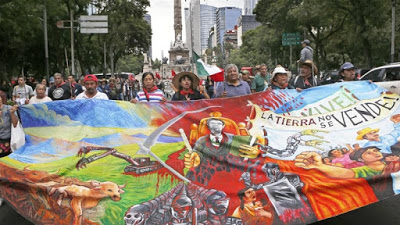Mexico is on the verge of a major human disaster
 |
| Paloma Martinez – October 9, 2018 |
Mexico City is in the throes of a heated conflict over plans for a new international airport.
It’s a monster project: one of the biggest public works in Mexican history, with an initial price tag of $13.3bn.
Once completed, the airport, known locally by its Spanish acronym, NAICM, will boast no fewer than six runways with a capacity of 125 million passengers annually, making it the second-largest airport in the world.
Billionaire Carlos Slim has invested heavily in the project, former president Enrique Pena Nieto has put all his political firepower behind it, and Mexico’s elite see it as a jewel in the crown of the nation.
NAICM is being built on a vast tract of rural commons, a marshy wetland, northeast of Mexico City, the last remnants of the ancient Lake Texcoco. Spanish conquistadors drained it in the 1600s after they destroyed the Aztec city of Tenochtitlan, known for its glorious canals and waterways.
Now the Mexican government wants to finish the job. There are more than 15 municipalities and hundreds of communities living in the area, including many indigenous Nahuas. The government has acquired the territory through a series of shady land grabs over the past 17 years, stripping residents of their traditional tenure rights.
The people have not gone away quietly: dispossessed peasants have organised themselves under the banner of the People’s Front in Defense of Land, pushing back against the government’s plans despite violent police repression. And a coalition of civil society organisations and artists recently launched a campaign against the mega-project, using the hashtag #YoPrefieroElLago – “we prefer the lake”.
This is not just a matter of land rights. There is also a very real risk of environmental catastrophe if the airport goes ahead. The NAICM site is home to 250 bird species, many of which are endangered. The aquifer beneath will almost certainly be destroyed, closing off a major source of water for Mexico City and exacerbating an already-frighteningregional water crisis.
The grievances are piling up, and protests are mounting, but the Mexican authorities keep hitting back with the same response: growth. The airport, they say, is an investment in Mexico’s long-term economic growth. And growth, we’re told, is progress.
Activists behind #YoPrefieroElLago reject this narrative. The easy equivalence between growth and progress may have seemed reasonable back in the 1950s, when the environment was relatively stable. But as our global civilisation bumps up against the harsh realities of climate change, mass extinction, and ecological collapse, it makes less and less sense. In fact, the usual narrative has it exactly backwards: as we scramble to reverse ecological breakdown, growth is emerging as the greatest enemy of progress.
The rush to build mega-airports like NAICM is an obvious example of this paradox. Air travel is an ecological disaster. The industry is set to double in size by 2035, and by 2050 could contribute up to 22 percent of total greenhouse gas emissions.
Projects like NAICM might cash in on this growing industry, but only by contributing significantly to climate breakdown. As we hurtle towards the 1.5C threshold that the Paris Agreement promised to respect, we should be finding ways to scale down air travel, not expand it.
The Mexican government’s argument is that the country needs GDP growth in order to galvanise “development” and improve the lives of ordinary people. But if that’s the objective, a new mega-airport seems a rather circuitous way to get there. As the People’s Front in Defense of Land points out, “The NAICM is not a work that benefits the people of Mexico, but the interests of the economic elite of the country.”
After all, only 30 percent of Mexican citizens have ever travelled by air. The project’s real beneficiaries will be Carlos Slim, the jet set, and the gaggle of multinational firms that have secured the contracts – in proceedings mired by corruption.
If Mexico’s government is truly interested in improving people’s lives, there’s a lot they can do right now, without any additional economic growth at all.
Take a look at Costa Rica, for instance. With a life expectancy of 79.6 years and levels of wellbeing in the top seven percent of the world, Costa Rica vastly outpaces Mexico and even matches many Scandinavian nations in these areas. And they do it with 12 percent less GDP per capita than Mexico has. How? Simply by investing in high-quality public healthcare, education and social security, rooted in the principle that everyone – regardless of income – should have equal access to these services as a basic right. No mega-airports necessary.
We can’t just assume that GDP growth will somehow magically improve people’s lives, as though any kind of economic activity will automatically deliver human progress. It’s much more efficient – and ecologically sane – to directly target the things we want. Healthy communities? Happy citizens? Livable wages? Clean air and water? Healthy food? Green spaces? Renewable energy?
Mexico’s government should focus on improving the conditions for human prosperity, rather than blindly hoping that perpetual GDP growth will do it for them.
By defending the lake, residents and activists are standing against a long history of colonisation and advancing a powerful alternative vision – one that sees human prosperity as intimately bound up with our planet’s ecology.
As we stare down the barrel of climate change and ecosystem breakdown, we would be wise to pay attention.
The views expressed in this article are the author’s own and do not necessarily reflect Al Jazeera’s editorial stance.


